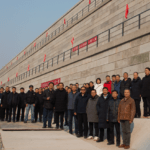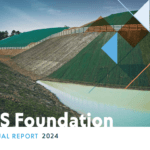 An IGS member for more than three decades and recently re-elected for a fourth term to the IGS Council, Pietro Rimoldi has seen many firsts in the development of the society and geosynthetics. Here he shares his thoughts on the challenges and opportunities to come.
An IGS member for more than three decades and recently re-elected for a fourth term to the IGS Council, Pietro Rimoldi has seen many firsts in the development of the society and geosynthetics. Here he shares his thoughts on the challenges and opportunities to come.
Tell us a bit about your involvement with the IGS.
I’ve been a member of the IGS for more than 30 years. I have been elected as a Council Member four times: 1994–1998, 1998–2002, 2014–2018 and 2018–2022. During my first term I proposed and drafted the first IGS Code of Ethics. In all four terms I have been involved in the Educational Committee and from 2015 until August 2020 I have been the Chair of the Technical Committee on Hydraulics (TC-H). At the recent Council meeting on September 9, 2020, I was nominated new Chair of the Technical Committee on Reinforcement (TC-R).
Please share some recent key developments in the geosynthetics hydraulics sector.
The functions of TC-H are filtration, drainage, erosion control, and coastal protection. There is ongoing development of specific products for the applications related to all the four functions. In particular manufacturers are developing geocomposites that can serve more than one function, with higher and higher capacity to solve difficult problems through enhanced performance.
The four functions mentioned can be applied in many different fields, and I think that the largest opportunities for market development will be in agriculture and mining applications. The main challenge will be to reach a worldwide agreement about testing norms and design methods, which are still suffering from too many geographical differences. This is a big obstacle to technical and marketing development.
How has the IGS evolved since you joined?
From a small society known only to the few people working in the geosynthetic sector, the IGS has become a very important society, with worldwide membership and a very high reputation. Nowadays there is almost no one in civil engineering who doesn’t know geosynthetics and IGS.
The IGS has evolved into a well-organized and structured society. With the formation of the Technical Committees, the capacity of the IGS to educate and stimulate interest in the use of geosynthetics has dramatically increased. Yet the knowledge of products, applications, design methods, installation procedures is still limited in the worldwide engineering community, hence IGS educational efforts need to be even more expanded.
Tell us a bit about your background and interests outside the IGS.
I have a degree in Civil Engineering, with specialization in hydraulics. I also completed several courses in geotechnics, reinforced soil, bioengineering, and erosion control techniques.
For 15 years I worked for an Italian geosynthetics manufacturer. I was involved in all aspects of geosynthetic engineering (product development, testing, design, etc.). These experiences allowed me to become a Professional Engineer, and for the last 20 years I’ve really enjoyed designing and consulting in all fields of Civil Engineering, obviously including projects with an important geosynthetic component.
Besides my professional activity, I’m involved in local and international charity and public service projects as a member of the Rotary Club in Milan. As an example, as a volunteer I designed and directed the construction works of an aqueduct for bringing potable water to 5,000 people in a town on the Peruvian Andes, at 4,000m altitude, all funded by the Rotary.
How has civil engineering changed, and how do you see it develop?
I work in civil engineering at 360°, hence I have to deal with concrete, steel, water, soil and plastic. The entire construction industry has experienced important developments in the last 30-40 years. Tools and machinery have increased in power and performance; just think of drilling and tunnelling machines, cranes and bulldozers, rock and metal cutting tools.
Industrial construction materials have enjoyed fantastic technological advancements; just compare today’s performance of glass, metal alloys, plied wood, concrete, chemical grout, etc., with the performance of these materials 40 years ago.
Design and analysis methods have seized all the possibilities offered by computers and information technology, including CAD, BIM, FEM, DEM, and many other well-known acronyms of computational and drawing techniques. Even topographical surveying uses the fantastic developments of modern optics, laser, radar, satellite imagery, and drones.
But when I look at the developments in civil engineering in the last half century I always note that so many advanced structures and works could not happen without geosynthetic engineering.
What can the industry do when it comes to sustainability? What is it getting right, where does it need to improve?
The construction industry has been among the first entities to understand that the future of the world requires sustainability, but many times the spring to move towards sustainable products, processes and techniques has not been ethics but marketing. Sustainability has become an abused word, without a well-defined meaning. For example, are electric cars sustainable? Has anyone thought about the implications of digging, refining, and transporting huge quantities of lithium for the batteries? Hence, the next step should be to conjugate ‘sustainability’ with ‘responsibility’, in ethical, social, environmental, and economic terms.
Have you worked on any notable projects?
In geosynthetic engineering I have designed hundreds of projects all around the world, including retaining walls, landslide stabilisation, landfills, roads and railways, erosion control on slope and water courses, and so on. I like to remember that I designed or co-designed the at-that-time tallest reinforced soil structures in the world, like a 35m high wall in Taiwan in the early 90s and a 84m high wall in Sikkim, India, in early 2010s.
I also remember the design of the first landfill capping in Italy (in Cerro Maggiore, close to Milan), which featured GCL for waterproofing, draining geocomposites, reinforced geomats for veneer reinforcement and surface erosion control.
But I also remember research projects, like a laboratory rainfall simulator for studying erosion control, the first instrumentation of a geogrid for railway stabilisation and the first full scale testing of a geogrid reinforced rockfall protection embankment. Other memorable projects include developments of design methods for geocells on slopes and draining systems with geosynthetics.
SEE ALSO: 10 Questions With… Francesco Fontana
Finally, I was in the first group of experts who steered the formation of CEN TC 189 and ISO TC 221 on Geosynthetics, which eventually developed almost 100 test methods for geosynthetics.
What has been your most memorable moment so far with the IGS?
A project that afforded the IGS Award in 2002 to the Italian team composed of Daniele Cazzuffi, Piero Sembenelli, Alberto Squero, and myself, for the development of the geosynthetic waterproofing system of the upstream face of concrete dams. It has been a very important advancement both in geosynthetic and dam engineering, and so far it is the only IGS Award granted to Italians.

What do you enjoy the most about being involved in the IGS, and what are you looking forward to?
I most enjoy the possibility to share knowledge, leadership, and related responsibilities. My highlights have included drafting the IGS Code of Ethics and steering the formation of the Technical Committee on Hydraulics.
I’m involved, together with all the Italian IGS Chapter Agi-Igs, in the organisation of the 12th International Conference on Geosynthetics, which will be held in Rome in September 2022. I’m also very interested in experiencing the new virtual conferences, like the next GeoAmericas, and more publications of online journals.
Do you have any messages for members?
Geosynthetics has often been defined as the most important advancement in civil engineering in the last 50 years. Yet geosynthetic engineering is still a young discipline, continuing to improve and develop through the ingenuity and enthusiasm of manufacturers, installers, professionals and academics. So, the message is: stay tuned on geosynthetics, the next invention is just coming.
I consider that geosynthetic engineering is one of the most transversal disciplines, requiring knowledge of geotechnics, hydraulics, mechanics, structural and transport engineering, chemical and environmental engineering, material science, laboratory and field testing. From my experience, a young engineer needs two to three years of post-degree studies to gain enough knowledge of geosynthetics, rather than just one hour introductory lesson on geosynthetics during the degree course, if at all.
I would like universities around the world to start a degree in Geosynthetic Engineering, which would easily find sponsorships from manufacturers, engineering companies and contractors.
MORE QS: 10 Questions With… Neil Dixon






















